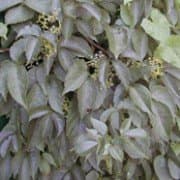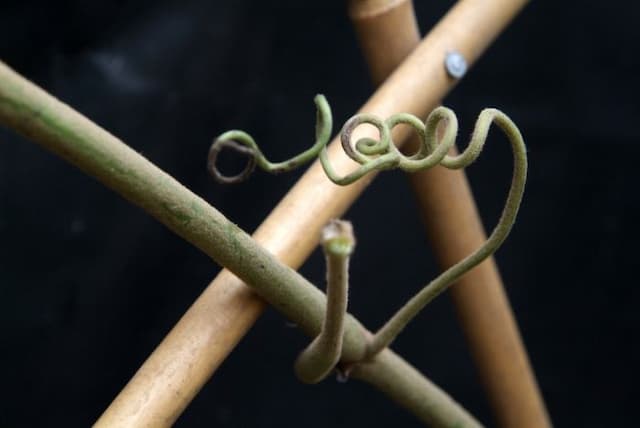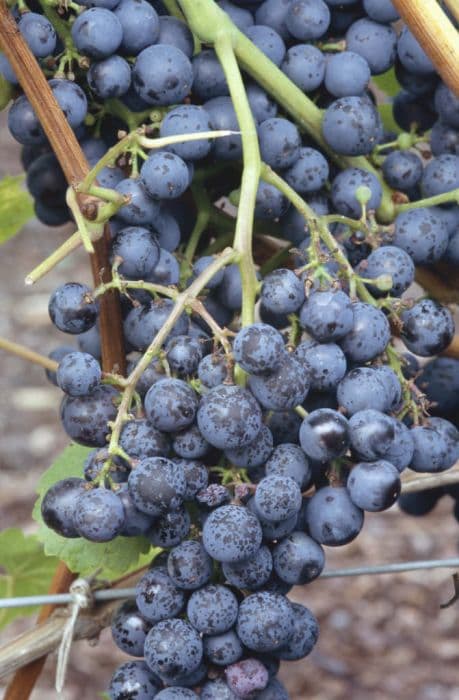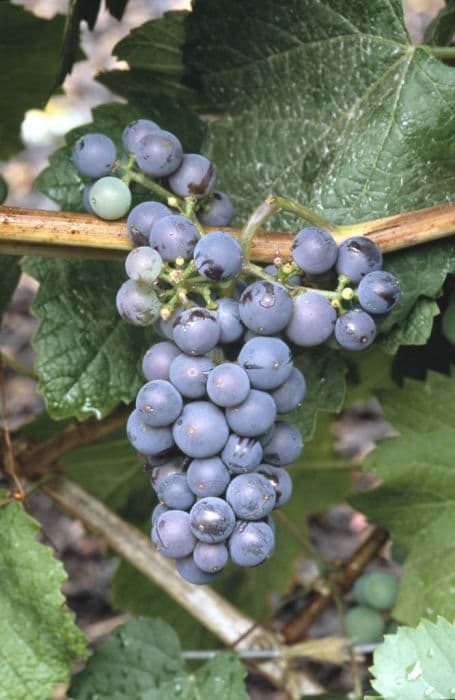Rondo Grape Vitis 'Rondo' (O/b)

ABOUT
Vitis 'Rondo' is a variety of grapevine known for its decorative and fruitful yields. Its striking appearance is characterized by detailed foliage and robust bunches of grapes. The leaves of this plant are large and typically three-lobed, with edges that are jagged and pointy. During the growing season, the green foliage provides a lush backdrop for the developing fruit. As the seasons change, the leaves might turn into stunning shades of red or purple, adding a blaze of color to the garden landscape. Meanwhile, the grapes themselves are typically dark, ranging from deep blues to near-black, giving a bold visual contrast against the foliage. Typically, these grapes are encased in a fine powdery bloom, which is easily rubbed off when touched. The vine itself sends out long, winding tendrils that seek support, curving and wrapping around any available structure. The bark on older parts of the plant is usually shaggy, textured by peeling strips that reveal different shades beneath its surface. Clusters of tiny, inconspicuous flowers precede the fruit, their delicate beauty often unnoticed amidst the expanse of leaves. The grapes mature into tightly packed clusters that hang heavily from the vine, each orb plump with juice, awaiting harvest. The appearance of the fruit, ripening under the sun, is often a telltale sign of the coming autumn, making the Vitis 'Rondo' a plant that not only bears fruit but provides seasonal interest throughout the year.
About this plant
 Names
NamesFamily
Vitaceae
Synonyms
Rondo Grape
Common names
Vitis 'Rondo'
 Toxicity
ToxicityTo humans
The common name for Vitis 'Rondo' is grapevine, specifically a variety used in wine production. Grapevines, including 'Rondo', are not toxic to humans when the fruit is consumed normally—in fact, grapes are a popular and healthy food. However, other parts of the plant, such as the leaves and vines, are not intended for consumption and can cause mild stomach upset if eaten in large quantities. The symptoms are generally not severe and might include nausea, vomiting, or diarrhea. There is no widespread documentation of significant poisoning from ingesting the non-fruit parts of the grapevine in humans.
To pets
The common name for Vitis 'Rondo' is grapevine. All parts of grapevines, including the grapes themselves, are toxic to dogs and cats. Consumption of grapes or raisins (dried grapes) by these pets can lead to acute kidney failure, which is a potentially life-threatening condition. Symptoms of grape or raisin poisoning in pets may include vomiting, diarrhea, lethargy, abdominal pain, decreased appetite, and signs of kidney failure such as decreased urination, weakness, and potentially coma. Rapid veterinary attention is essential if a pet ingests any part of a grapevine.
 Characteristics
CharacteristicsLife cycle
Perennials
Foliage type
Deciduous
Color of leaves
Green
Flower color
Greenish-yellow
Height
4-6 feet (1.2-1.8 meters)
Spread
3-5 feet (0.9-1.5 meters)
Plant type
Climber
Hardiness zones
5
Native area
Europe
Benefits
 General Benefits
General Benefits- Easy to Grow: Vitis 'Rondo' is known for being hardy and easy to cultivate, which makes it a good choice for beginner gardeners.
- Attractive Foliage: It has attractive leaves that can add aesthetic appeal to gardens and landscapes.
- Shade Provider: The vine can be trained over arbors or pergolas, providing a natural canopy that offers shade.
- Erosion Control: Its root system helps stabilize soil, which can prevent erosion on slopes and banks.
- Wildlife Habitat: It provides a habitat for various species of birds and insects, which find food and shelter in the vine's foliage and fruit.
- Edible Fruits: The plant produces grapes that can be eaten fresh, made into juice, or fermented into wine.
- Seasonal Interest: Vitis 'Rondo' exhibits seasonal changes from budding leaves, to summer growth, to autumn color, offering visual interest throughout the year.
- Privacy Screen: When grown on fences or trellises, the vine can create a living screen, offering privacy to a garden space.
- Cultural Significance: As a grapevine, it has historical and cultural importance, especially in the context of wine production.
 Medical Properties
Medical Properties- This plant is not used for medical purposes.
 Air-purifying Qualities
Air-purifying QualitiesThis plant is not specifically known for air purifying qualities.
 Other Uses
Other Uses- Vitis 'Rondo', known as grapevine, can be used as a natural dye source where the skins of the grapes provide pigments for fabric or artisanal crafts.
- Grapevine wood, being sturdy and of good quality, can be repurposed to create small woodworking projects such as frames or carved ornaments.
- The leaves of the grapevine can be utilized in culinary arts, particularly in Mediterranean cuisines, to wrap and cook dishes such as dolmas.
- When dried, the vines can serve as rustic decor elements or be woven into wreaths and other decorative items for home or events.
- Grapevine tendrils can be artistically integrated into floral arrangements or used as a natural twist tie in gardens.
- The sap from grapevines can be used as a natural, albeit temporary, glue for small fixes or craft projects.
- Trained over arbors or pergolas, grapevines provide natural, leafy shade during the warmer months with the added benefit of fruit.
- After pruning, grapevine cuttings can be repurposed as support stakes for other plants in the garden.
- Grape leaves can be pressed and dried to create botanical art pieces or used as natural motifs in paper making.
- The grape harvest can become a social or educational event, inviting community participation and teaching about agriculture and viticulture.
Interesting Facts
 Feng Shui
Feng ShuiThe grapevine is not used in Feng Shui practice.
 Zodiac Sign Compitability
Zodiac Sign CompitabilityThe grapevine is not used in astrology practice.
 Plant Symbolism
Plant Symbolism- Fertility and Abundance: As a variety of grapevine, Vitis 'Rondo' represents fertility due to its abundant fruit production, signifying growth and generativity.
- Transformation: The grapevine undergoes a transformation from flower to fruit, symbolizing change and evolution.
- Prosperity: The grape, being a historically significant crop, is associated with prosperity and well-being.
- Continuity: Vines are perennial, living for many years, which can symbolize continuity and the enduring nature of existence.
- Joy and Celebration: Grapes are used to make wine, which is often associated with celebration, joy, and conviviality.
- Vitality: The vigorous growth of grapevines symbolizes robust health and vitality.
 Water
WaterGrapevines like Vitis 'Rondo' need consistent moisture, especially during the growing season. Water young vines once a week with approximately 1 gallon of water per plant, ensuring it reaches the root zone. Mature grapevines may require less frequent watering, depending on rainfall and soil conditions, but generally, they need about 4-6 gallons every two weeks. During the hot summer months or in dry conditions, increase watering to ensure vines do not experience drought stress, but be careful not to overwater as grapevines are susceptible to root rot. Reduce watering as the plant goes dormant in the fall.
 Light
LightGrapevines, such as Vitis 'Rondo', thrive in full sunlight. They require a minimum of 6 to 8 hours of direct sunlight daily for optimal growth and fruit production. Place the plant in a location where it receives ample morning light and consistent exposure throughout the day. Avoid heavily shaded areas, as insufficient light can lead to poor fruit development and increased susceptibility to diseases.
 Temperature
TemperatureVitis 'Rondo' grapevines perform best in a temperature range between 55°F and 85°F. They can tolerate minimum winter temperatures down to about 20°F once established. During the growing season, temperatures consistently above 85°F can inhibit grape development. It's crucial to ensure that grapevines are planted in an area where they can survive winter chill but are protected from extreme winter cold that can damage or kill the vine.
 Pruning
PruningPruning Vitis 'Rondo' grapevines is essential for maintaining plant health, ensuring good air circulation, and promoting fruit production. Prune annually during late winter or early spring before the buds begin to swell. Remove dead or diseased wood, thin out crowded areas, and trim back canes that bore fruit the previous year. Pruning encourages new growth, which is where fruit develops. It's best to keep some older wood as well as newer canes for a balance of fruit production and vine vitality.
 Cleaning
CleaningNot needed
 Soil
SoilThe best soil mix for a Rondo grapevine is well-draining soil that's rich in organic matter. The soil pH should ideally be between 5.5 and 6.5, slightly acidic to neutral. Amend with compost and possibly a bit of sand for improved drainage.
 Repotting
RepottingRondo grapevines are typically planted outdoors and do not require repotting. However, if they are kept in containers, repot every 2-3 years to prevent root crowding and replenish nutrients.
 Humidity & Misting
Humidity & MistingGrapevines like 'Rondo' prefer moderate humidity levels but are generally adaptable. They thrive in an outdoor environment where the humidity naturally fluctuates.
 Suitable locations
Suitable locationsIndoor
Ensure large pot, strong support, ample light, and good air flow.
Outdoor
Plant in full sun, support with trellis or arbor, protect from wind.
Hardiness zone
5-9 USDA
 Life cycle
Life cycleVitis 'Rondo' (often known as the Rondo grapevine) begins its life cycle as a dormant cutting or grafted vine before it breaks dormancy in spring with budburst followed by rapid leaf growth. Flower clusters then emerge and, if pollinated, will develop into grape clusters throughout the summer. As temperatures increase, the grapes go through veraison, a stage in which they soften and change color indicating the onset of ripening. The fruit matures by late summer or early fall, at which point the grapes are harvested for consumption or wine production. Following harvest, the vine gradually enters senescence, where the leaves change color and fall off, and the vine goes into dormancy to conserve energy through the winter months. This cycle repeats annually with proper care and pruning to ensure vine health and fruit production.
 Propogation
PropogationPropogation time
Spring-Early Summer
Grapevines such as Vitis 'Rondo' can be propagated by hardwood cuttings, a popular method among viticulturists. The ideal time for taking hardwood cuttings is during the dormant season, usually late fall through winter. Gardeners frequently select healthy, mature canes from the current year’s growth and cut them into lengths of about 12 to 18 inches (approximately 30 to 45 centimeters), ensuring there are several buds on each piece. The lower end of the cutting is usually dipped in rooting hormone to encourage root development and then planted directly in the soil or in pots with a sandy loam mix. The cuttings require consistent moisture, but not waterlogged conditions, and should be kept in a bright, indirect light setting until they have rooted well, after which they can be transplanted to their final location in the vineyard or garden.

![Grape [Claret Cloak]](/_next/image?url=https%3A%2F%2Fplants-admin.emdemapps.com%2Fimages%2Fplants%2F%2Fimages%2F604b602abe2f8.png&w=640&q=75)







